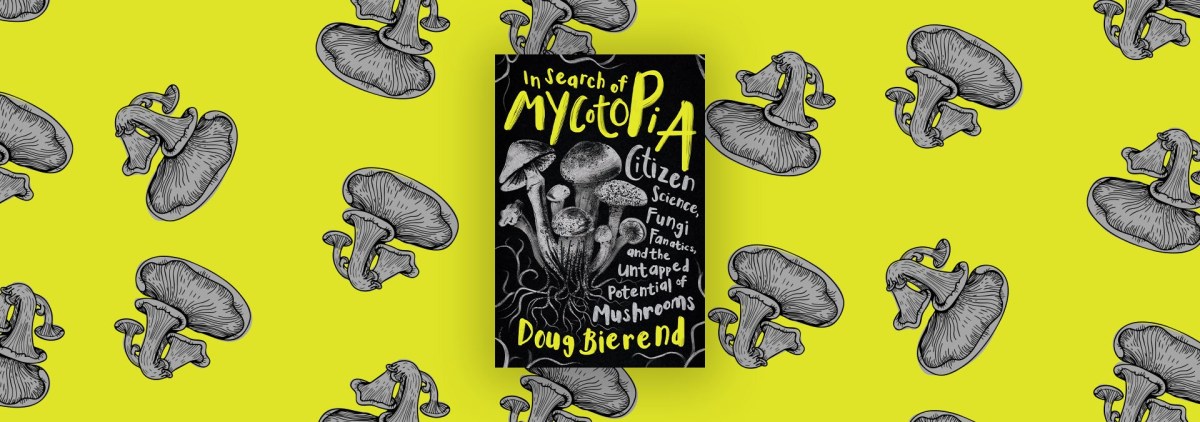[ad_1]
Online and in an assortment of counter-cultural convergences, a movement to cultivate, research and celebrate fungi, the most unknown of kingdoms, grows every day. All the while pharmaceutical companies, ambitious marketers and other profit-seekers watch and wait for the right moment to strike. In Search of Mycotopia: Citizen Science, Fungi Fanatics, and the Untapped Potential of Mushrooms offers a deep dive into the current mushroom craze and some of its many characters, including community-minded entrepreneurs, biologists, underground festival organizers and citizen scientists. Author Doug Bierend also offers a word of warning and thoughtful guidance as the mushroom underground stands poised to hit the mainstream.
The 2008 TED Talk, called “Six Ways Mushrooms Can Save the World” by mycologist Paul Stamets, is often referenced as the inspiration behind this new generation of fungi enthusiasts. In 17 minutes, Stamets lays out the vast untapped potential of fungi, from eliminating toxic waste from land and water to offering a cure for viruses like H1N1. While Bierend could have easily written a book springboarding off the success of Stamets’ approach, highlighting the miraculous promise of fungi, he instead rejects this handily marketable tendency to spotlight heroic individuals and utopic solutions, focusing instead on the collectivist efforts, alternative models, and diversity of the subculture, ultimately identifying these as the mycelial metaphor that offers a way forward. Indeed, Bierend affirms that “game-changing innovations” never really bear the promised fruit given the “extractive mindset that shapes and limits the potential of any good ideas.” He instead centers the people and places that usually get lumped together under terms like “grassroots” and “bottom-up approaches”: small-scale collectivist mushroom farms, fermentation workshops in the Tennessee mountains, meetings of the POC Fungi Community in San Diego.
Bierend first lays a solid scientific foundation to pin down what fungi even are, covering their cell structure, life cycle, taxonomy and DNA, as well as the current state of research on the life form. He offers both facts and wonderment. Readers will become comfortable with the basic biology of fungus and acquire working knowledge of terms like inoculation, substrate and hyphae, while perhaps also seeing the world anew with the realization that this living substance exists everywhere, in microscopic quantities in the air around us and in vast networks in the soil beneath our feet. (The largest living thing on earth, Bierend mentions, is the “Humongous Fungus high in Oregon’s Blue Mountains; the web of its mycelial ‘body’ extends upwards of three square miles.”)
At the same time, Bierend weaves in a sociocultural meta-analysis of Western science, raising questions of how societies decide what defines knowledge and who is an expert. He highlights, for example, the intersection between colonization, the development of modern biology, and the destruction of vast indigenous knowledge. Bierend also offers a fascinating inquiry into “citizen science,” exploring the ways average, uncredentialed individuals have contributed to scientific knowledge of fungi, from the 19th-century foraging societies in Britain and the U.S. to current mushroom hunters who crowdsource the identification of species with smartphone photos and help determine species’ taxonomic relationship using handheld DNA sequencing devices.
Most intriguing are the passionate people Bierend profiles, each with a different mission but a shared driving obsession for mycelium, many of them claiming that mushrooms chose them. He visits mycophiles all over the Western Hemisphere, including stops in the Royal Botanic Gardens in London, the shores of Great Salt Lake in Utah, and the jungles of Ecuador. In Pennsylvania, he meets William Padilla-Brown, a hip-hop artist and entrepreneur, who wrote the first cultivation guide for temperamental, medicinally promising Cordyceps mushrooms, and founded MycoFest, an annual gathering focused on mycoremediation, medicinal mushrooms, and permaculture. We’re also introduced to Dr. Patricia Kaishian, who, in addition to researching tiny, mysterious fungi, co-authored a paper on mycology as a queer discipline, exploring the “situation of mycology as a boundary-bending discipline rife with ‘queer’ dynamics.” While certainly offering revelations about mushrooms, In Search of Mycotopia is ultimately a kind of social history, documenting a uniquely 21st-century subculture, hyper-conscious of the ways that attitudes towards race, capitalism, gender, and the environment can’t be separated from any scientific, commercial, or social enterprise.


NONFICTION
In Search of Mycotopia:
Citizen Science, Fungi Fanatics, and the Untapped Potential of Mushrooms
Doug Bierend
Chelsea Green Publishing Company
Published March 10, 2021
[ad_2]
Source link
